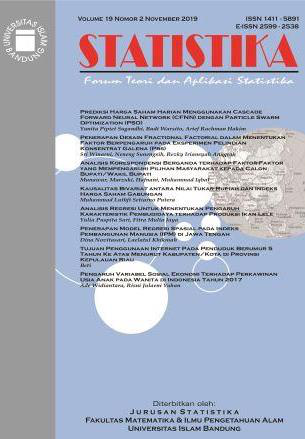Confirmatory Factor Analysis pada Indikator Kesembuhan Pasien Isolasi Mandiri Covid-19 di Indonesia
DOI:
https://doi.org/10.29313/statistika.v22i1.477Keywords:
Confirmatory Factor Analysis, Dukungan Sosial, Pengetahuan, Pasien Covid-19, Isolasi MandiriAbstract
ABSTRAK
Jumlah kasus terkonfirmasi positif Covid-19 di Indonesia pada September 2021 telah mencapai angka 4.204.116 Jiwa dengan pasien meninggal sebanyak 141 ribu orang atau tingkat kematian sebesar 3,4 persen. Kementerian Kesehatan Republik Indonesia melalui Satgas Penanganan Covid-19 telah menerbitkan pedoman pencegahan dan pengendalian Covid-19 untuk menekan angka kematian dan meningkatkan angka kesembuhan. Menurut pedoman tersebut, seseorang yang menjalani isolasi mandiri perlu diberikan perawatan kesehatan, dukungan sosial dan psikososial, serta kebutuhan dasar termasuk makanan, air dan kebutuhan pokok lainnya. Penelitian ini berusaha mengidentifikasi pengaruh faktor eksternal yang meliputi dukungan, serta faktor internal yang meliputi motivasi dan pengetahuan pasien terhadap tingkat kesembuhan penyintas Covid-19 isolasi mandiri. CFA digunakan apabila pengetahuan mengenai struktur suatu faktor laten diketahui. Struktur tersebut diperoleh berdasarkan kajian teoritis, hasil penelitian mengenai hubungan antara variabel yang diobservasi dengan variabel laten. Pendekatan CFA diterapkan untuk mengetahui indikator yang paling besar berpengaruh terhadap variabel laten dukungan sosial, pengetahuan dan motivasi kesembuhan. Pengambilan data primer dilakukan secara online dengan jumlah sampel sebanyak 148 responden penyintas Covid-19 di seluruh Indonesia pada bulan Agustus 2021. Hasil analisis CFA menunjukkan bahwa indikator DS1 (mendapatkan ungkapan empati, kepedulian, dan perhatian yang diberikan petugas terhadap penderita Covid-19) memiliki nilai loading factor terbesar yaitu 0,741. Pada variabel laten pengetahuan, indikator P7 (Tujuan pengobatan Covid-19 adalah menyembuhkan penderita, mencegah penularan dan kematian serta menurunkan tingkat penularan) memiliki nilai loading factor terbesar yaitu 0,767. Sedangkan pada variabel laten tindakan sembuh Indikator TS1 (Bersedia menjalani masa pengobatan dengan pemberian dalam waku pengobatan kurang lebih 14 hari) memiliki nilai loading factor terbesar yaitu 0,924.
ABSTRACT
The number of positive confirmed cases of Covid-19 in Indonesia in September 2021 has touched 4,204,116 people with the number of patients dying as many as 141,000 people or a death rate of 3.4 percent. The Ministry of Health of the Republic of Indonesia through the Covid-19 Handling Task Force has issued guidelines for the prevention and control of Covid-19 to reduce mortality and increase recovery rates. Based on these guidelines, people who are in self-isolation need to be provided with health care, social and psychosocial support, as well as basic needs including food, water and other basic needs. This study seeks to identify the influence of external factors which include support, as well as internal factors which include the motivation and knowledge of patients on the recovery rate of Covid-19 survivors in self-isolation. CFA can be used when knowledge of the composition or structure of a latent factor is known. The structure is obtained from theoretical studies, the results of research on the relationship between the variables studied and the latent variables. By using the CFA approach, it can be seen that the indicators that have the greatest influence on the latent variables of social support, knowledge and motivation for healing are known as loading factors. Primary data was collected online with 148 COVID-19 survivors across Indonesia in August 2021 as the sample. From the CFA analysis, it was found that the Social Support 1 (DS1) indicator, which is getting expressions of empathy, concern, and attention given by officers to Covid19 sufferers is the largest loading factor value, which is 0.745. This means that the influence of the DS1 indicator on the latent variable of Social Support is 0.745 or 74.5% is influenced by the DS1 indicator compared to the other 4 indicators, namely DS2, DS3, DS4, DS5. In the knowledge latent variable, the Knowledge 7 (P7) indicator, namely the purpose of Covid-19 treatment is to cure the patient, prevent transmission and death and reduce the transmission rate, which is the largest loading factor value, which is 0.767. Then on the latent variable of healing action, Healing Action Indicator 1 (TS1), namely being willing to undergo a treatment period with administration within a treatment time of approximately 14 days) is the largest loading factor value, which is 0.924.
References
Arum, R. (2020). Pembatasan Sosial Di Indonesia Akibat Virus Corona Ditinjau Dari Sudut Pandang Politik.
Hafeez, A., Ahmad, S., Siddqui, S. A., Ahmad, M., & Mishra, S. (2020). A review of COVID-19 (Coronavirus Disease-2019) diagnosis, treatments and prevention. In EJMO (Vol. 4, Issue 2).
Hair Jr, J. F., Hult, G. T. M., Ringle, C. M., & Sarstedt, M. (2021). A primer on partial least squares structural equation modeling (PLS-SEM). Sage publications.
Kemenkes. (2020). Kesiapsiagaan Menghadapi Infeksi COVID-19. https://www.kemkes.go.id/article/view/20101300001/ruang-isolasi-covid-19-di-semua-provinsi-masih-memadai.html
Priharsari, D. (2020). Pengolahan SEM Covariance-Based dengan Modul Lavaan pada Penelitian Sistem Informasi. Jurnal Sistem Informasi, Teknologi Informasi, Dan Edukasi Sistem Informasi, 1(1).
Rahmi, N. S. (2015). Analisis pengaruh dukungan motivasi dan pengetahuan terhadap tindakan penyembuhan penderita penyakit Tuberculosis (TB) di pesisir Surabaya dengan pendekatan SEM (Structural equation modelling) [Institut Teknology Sepuluh Nopember]. https://scholar.google.com/citations?view_op=view_citation&hl=en&user=yoqIxsMAAAAJ&citation_for_view=yoqIxsMAAAAJ:u-x6o8ySG0sC
Rahmi, N. S. (2020). Mapping Tingkat Kerawanan Covid-19 dan Faktor Akselerator Penyebaran Virus Antar Daerah di Indonesia Dengan Menggunakan Analisis Cluster Hierarki. Seminar Nasional Official Statistics, 2020(1), 73–81.
Rosseel, Y. (2012). Lavaan: An R package for structural equation modeling and more. Version 0.5–12 (BETA). Journal of Statistical Software, 48(2), 1–36.
Tapung, M. M., Regus, M., Payong, M. R., Rahmat, S. T., & Jelahu, F. M. (2020). Bantuan sosial dan pendidikan kesehatan bagi masyarakat pesisir yang terdampak sosial-ekonomi selama patogenesis Covid-19 di Manggarai. Transformasi: Jurnal Pengabdian Masyarakat, 16(1), 12–26.
Thompson, B. (2004). Exploratory and confirmatory factor analysis: Understanding concepts and applications. Washington, DC, 10694.
WHO. (2020). Coronavirus disease (COVID-19). https://www.who.int/emergencies/diseases/novel-coronavirus-2019
Yuliana. (2020). Wellness And Healthy Magazine Corona Virus Diseases (Covid-19). Wellness And Healthy Magazine, 2(1), 187.
Zhang, J., Lu, H., Zeng, H., Zhang, S., Du, Q., Jiang, T., & Du, B. (2020). The differential psychological distress of populations affected by the COVID-19 pandemic. In Brain, Behavior, and Immunity (Vol. 87, pp. 49–50). Academic Press Inc. https://doi.org/10.1016/j.bbi.2020.04.031
















